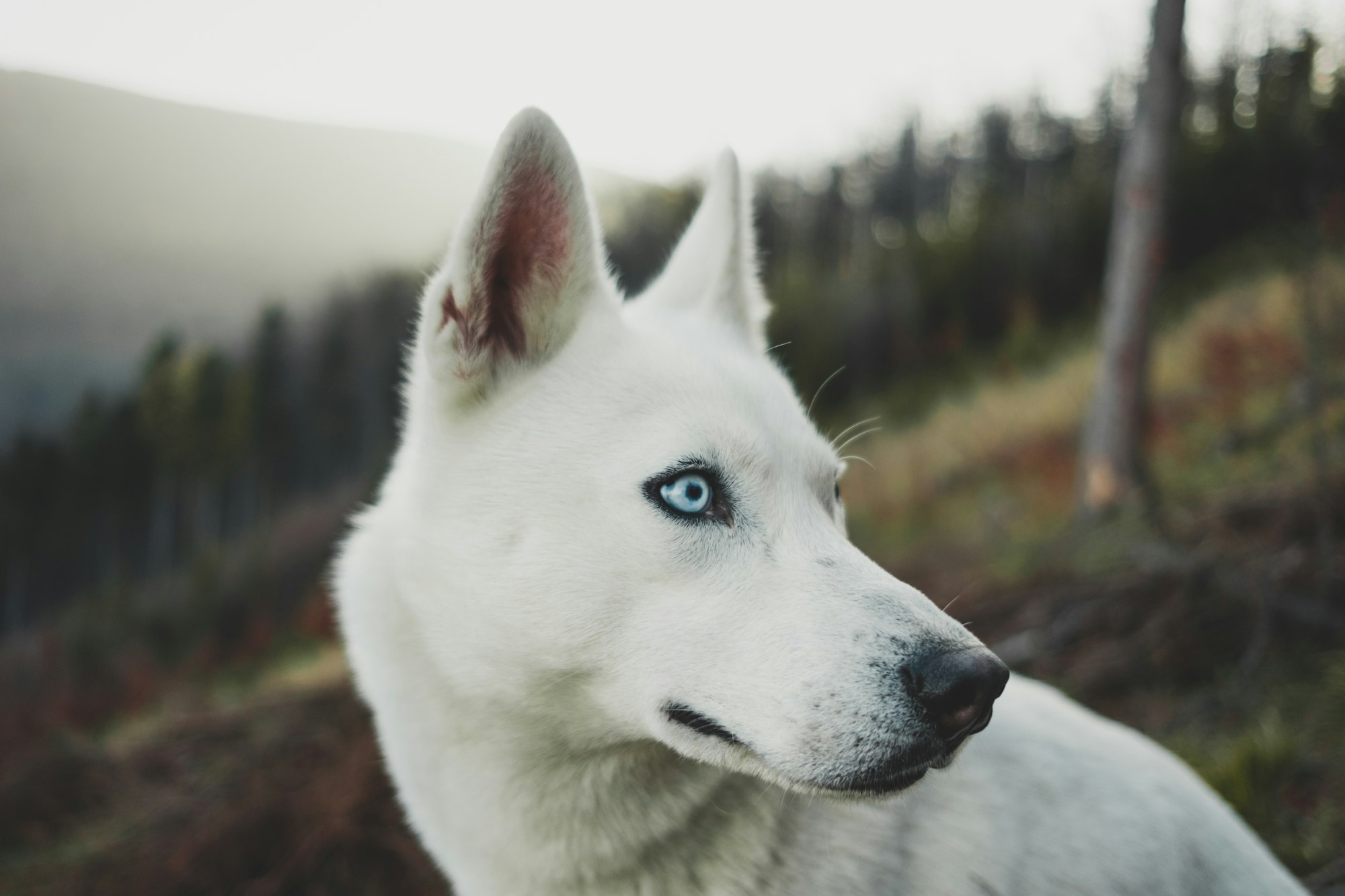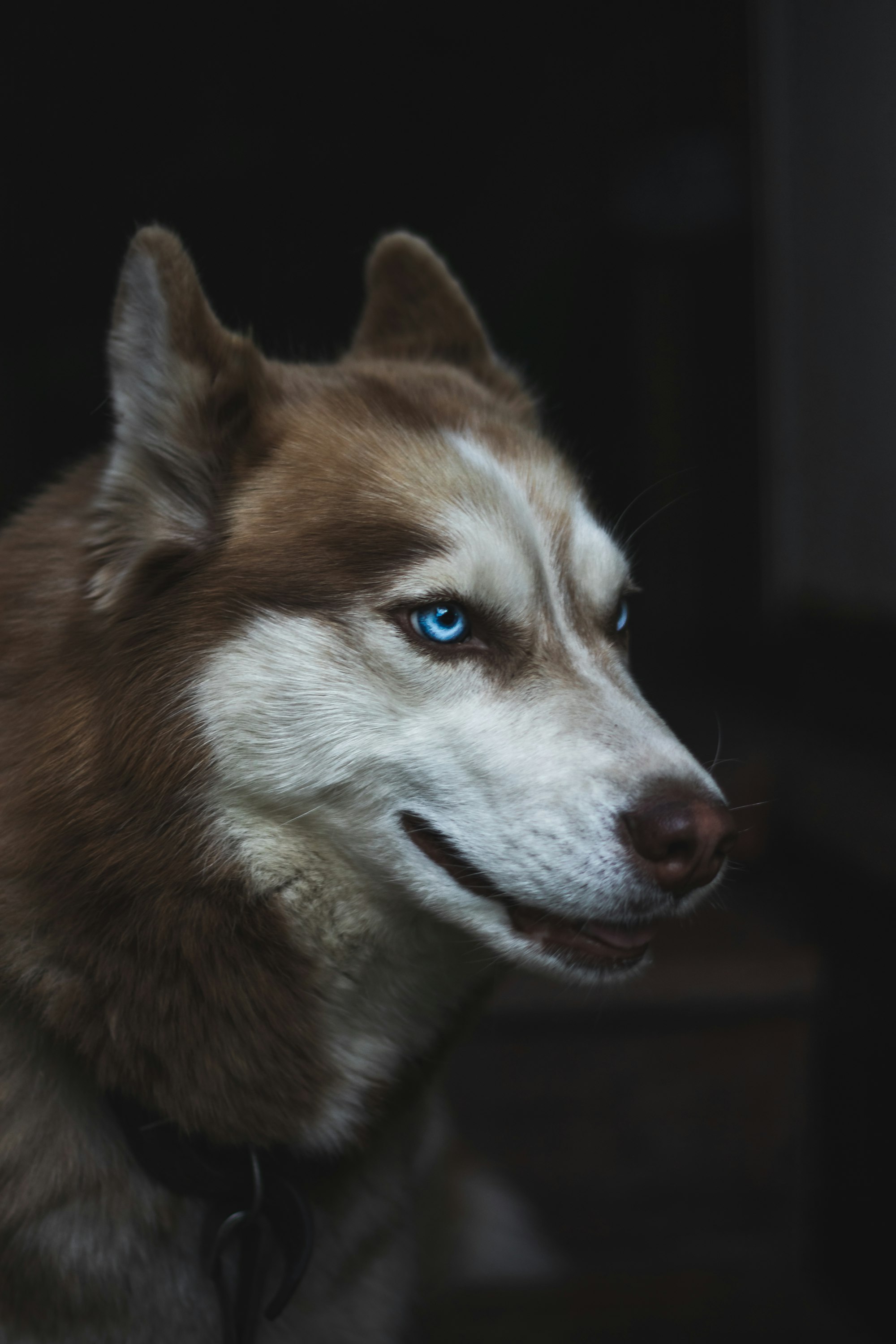Dogs are known for their incredible diversity, and this extends to their physical features, including eye color. While brown eyes are the most common, you might have wondered which dog breeds have blue eyes. In this article, we'll explore the intriguing world of blue-eyed dogs, the reasons behind their mesmerizing eye color, and the specific breeds known for this captivating trait.

Why Do Some Dogs Have Blue Eyes?
Blue eyes in dogs can be enchanting and captivating, but have you ever wondered why some dogs are blessed with this mesmerizing eye color? The answer lies in genetics and the interplay of specific factors:
Genetic Factors:
The primary reason some dogs have blue eyes is their genetic makeup. Specific genes control eye color in dogs, just as they do in humans. One of the key genes responsible for blue eyes in dogs is the "merle" gene. This gene can dilute the color of a dog's eyes, resulting in shades of blue or even multicolored eyes.
Lack of Pigmentation:
The color of a dog's eyes is determined by the presence and distribution of melanin, the pigment responsible for coloration in various parts of the body, including the skin, hair, and eyes. Blue eyes occur when there is a lack of melanin in the iris. Unlike brown eyes, which have a high concentration of melanin, blue eyes appear blue because they scatter light differently, reflecting the blue color back to our eyes.
It's important to note that not all dogs with blue eyes have the same genetic makeup. While some breeds are more prone to blue eyes due to specific genetic traits, the presence of blue eyes can vary even within the same breed. Additionally, blue eyes can be inherited or occur sporadically.
Understanding the genetic and pigmentation factors behind blue eyes in dogs adds to the fascination of these unique and beautiful animals. While genetics play a significant role in determining eye color, it's just one of the many intriguing aspects that make every dog an individual.
Dog Breeds with Blue Eyes
Blue eyes in dogs are a striking and rare feature, and they are more commonly found in certain breeds. Let's explore some of these captivating breeds known for their mesmerizing blue eyes:
Huskies
Siberian Huskies are perhaps the most iconic blue-eyed dogs. These striking canines often have icy blue eyes that seem to pierce through your soul. It's a distinctive feature of this breed that has captured the hearts of many.
Australian Shepherds
Australian Shepherds, also known as "Aussies," are another breed commonly associated with blue eyes. Their vibrant blue eyes are often paired with a merle coat, creating a truly stunning appearance.
Dalmatians
Dalmatians, famous for their spots, can also have blue eyes. While this is less common than in Huskies or Aussies, it's not unusual to find a Dalmatian with one or both eyes in this striking shade.
Weimaraners
Weimaraners are known for their silvery-gray coat and, sometimes, their beautiful blue-gray eyes. These dogs are often described as having a regal and captivating gaze.
Border Collies
Border Collies may have a variety of eye colors, including blue. Their intelligence and intensity are mirrored in their eyes, which can range from deep blue to a mix of colors.
Great Danes
Great Danes are gentle giants, and some of them have mesmerizing blue eyes. It's a rare sight, but when you see a blue-eyed Great Dane, it's truly unforgettable.
Shetland Sheepdogs
Shetland Sheepdogs, or Shelties, often have striking blue eyes that contrast beautifully with their lush double coats. These dogs are known for their agility and intelligence.
Siberian Huskies
We've mentioned them before, but it's worth emphasizing Siberian Huskies again. These dogs are the poster children for blue eyes in the canine world.
These breeds showcase the diversity of blue-eyed dogs, each possessing its unique charm and personality traits. While blue eyes are captivating, remember that the personality and care requirements of a dog should always be a primary consideration when choosing a pet.
Now, let's delve into other factors that can influence a dog's eye color.

Other Factors Influencing Eye Color
While genetics play a significant role in determining a dog's eye color, other factors can influence and even change their eye color over time. Here are some key considerations:
1. Age:
A dog's eye color can change with age. Many puppies are born with blue eyes, which may gradually darken as they mature. The final eye color is typically established by six to eight weeks of dog age. So, don't be surprised if your puppy's eyes transform as they grow.
2. Health Issues:
Certain health conditions can affect a dog's eye color. Cataracts, for example, can cloud the eye's lens, potentially changing its appearance. Similarly, glaucoma, a condition involving increased pressure within the eye, can impact eye pigmentation. Regular veterinary check-ups are crucial to monitor your dog's eye health and address any issues promptly.
3. Environment:
Environmental factors, such as exposure to sunlight, can influence eye color. Just as prolonged sun exposure can lead to changes in human eye color, it can also affect dogs. Excessive exposure to ultraviolet (UV) rays can potentially lighten or alter a dog's eye color over time. Protecting your dog's eyes from harmful UV rays is essential, especially for dogs with lighter-colored eyes.
In summary, while genetics are the primary determinants of a dog's eye color, age, health conditions, and environmental factors can all play a role in shaping and even changing their eye color. Understanding these factors can help you appreciate the fascinating intricacies of your furry companion's eyes.
Now, let's explore why blue-eyed dogs continue to capture our hearts and what it takes to care for these unique canines.
The Beauty of Blue-Eyed Dogs
The allure of blue-eyed dogs goes beyond their striking appearance. These canines often possess a unique charm that captivates dog enthusiasts and casual observers alike. Let's delve into what makes blue-eyed dogs so special:
1. Mesmerizing Gaze: The most obvious and enchanting feature of blue-eyed dogs is, of course, their eyes. Blue eyes, with their shades ranging from the palest baby blue to deep sapphire, create a mesmerizing and unforgettable gaze. It's as if you can peer into their souls through those azure windows.
2. Unique Individuality: Blue eyes in dogs are relatively rare, which makes them stand out in a crowd. When you encounter a blue-eyed dog, you're witnessing a unique individual, a one-of-a-kind companion with a special visual trait.
3. Personality Traits: While eye color doesn't dictate a dog's personality, many blue-eyed dogs are known for their intelligence, loyalty, and charisma. The twinkle in their eyes often mirrors their playful and spirited nature.
4. Endearing Mystique: Blue-eyed dogs seem to possess an aura of mystery and charm. Their gaze can convey a sense of depth and wisdom, leaving us pondering what thoughts lie behind those eyes.
5. Conversation Starters: Blue-eyed dogs are conversation magnets. When you're out and about with your blue-eyed companion, you're bound to attract attention and questions from curious passersby. This can be a wonderful way to connect with fellow dog lovers.
6. Aesthetic Variety: Blue eyes come in various shades, adding to the diversity among blue-eyed dogs. Whether they have icy blue, sky blue, or even a mix of blue and brown in each eye, the range of colors adds to their individuality.
7. Engaging Photography Subjects: If you enjoy capturing moments with your furry friend through photography, blue-eyed dogs provide stunning subjects. Their eyes often become focal points of memorable photographs.
While blue eyes in dogs are undoubtedly captivating, it's essential to remember that a dog's true beauty goes beyond its physical traits. Temperament, loyalty, and the bond you share with your canine companion are the most significant aspects of their appeal.
In the next section, we'll discuss how to care for dogs with blue eyes, ensuring their eye health and overall well-being.
Caring for Dogs with Blue Eyes
Caring for dogs with blue eyes involves some considerations to ensure their eye health and overall well-being. Here are essential tips for taking care of your blue-eyed canine companion:
- 1. Regular Eye Check-ups: Schedule regular veterinary eye exams to monitor your dog's eye health. These check-ups can detect any issues early on, such as cataracts or glaucoma, which can affect dogs of any eye color.
- 2. Sun Protection: Dogs with lighter-colored eyes, including blue, may be more sensitive to sunlight. Consider providing them with UV-protective eyewear when spending extended periods outdoors in bright sunlight. These protective goggles shield their eyes from harmful UV rays and prevent potential damage.
- 3. Proper Nutrition: Ensure your dog's diet includes essential nutrients that support eye health. Vitamin A and antioxidants, found in quality dog food, contribute to maintaining good vision and overall eye health.
- 4. Gentle Cleaning: Keep your dog's eyes clean by gently wiping away any discharge or debris. Use a soft, damp cloth or specialized dog eye wipes for this purpose. Be careful not to touch or scratch their eyes while cleaning.
- 5. Avoid Irritants: Protect your dog's eyes from irritants such as smoke, chemicals, or dust. Ensure a clean and safe environment for your pet, especially if you have a breed prone to eye issues.
- 6. Regular Exercise: Regular exercise is crucial for your dog's overall health, including their eye health. Physical activity helps maintain proper blood circulation, which benefits the eyes.
- 7. Behavioral Stimulation: Mental stimulation and engagement are as vital as physical exercise. Puzzles, interactive dog toys, and games can help keep your dog's mind active and happy.
- 8. Adequate Rest: Make sure your dog gets enough rest. Quality sleep supports overall well-being, including eye health.
- 9. Bonding and Socialization: Spend quality time with your dog, as strong bonds and socialization are essential for their emotional and mental health.
- 10. Regular Grooming: Keep up with grooming tasks, especially for breeds with long fur that can obstruct vision. Trim hair around their eyes to prevent irritation and discomfort.
By following these care guidelines, you can help ensure that your blue-eyed companion enjoys a happy and healthy life. Remember that the well-being of your dog encompasses more than just their eye color, and your love and attention play a significant role in their overall happiness.
In the concluding section, we'll summarize the key points of this article and provide answers to some frequently asked questions (FAQs) about dogs with blue eyes.

Conclusion
In the world of dogs, eye color adds another layer of diversity and intrigue. While blue eyes are relatively rare in the canine kingdom, they continue to captivate us with their beauty. Whether you own a blue-eyed dog or simply admire them from afar, their unique charm is undeniable.
Understanding the factors that contribute to blue eyes in dogs, including genetics and pigmentation, can deepen our appreciation for these enchanting creatures. Remember to care for your blue-eyed companion's eyes with regular check-ups and protective measures to ensure they continue to shine brightly.
FAQs
Here are the Frequently Asked Questions (FAQs) about dogs with blue eyes:
- Q1: Are blue eyes in dogs common?
- Blue eyes in dogs are relatively rare. They are more commonly found in certain breeds with specific genetic traits.
- Q2: Can a dog's eye color change over time?
- Yes, a dog's eye color can change, especially in puppies. Many puppies are born with blue eyes that may later darken or shift in shade as they mature. The final eye color is typically established by six to eight weeks of age.
- Q3: Is there any health concern associated with blue eyes in dogs?
- Blue eyes themselves are not a health concern. However, some health issues, such as cataracts or glaucoma, can affect a dog's eye color. Regular veterinary check-ups are essential to monitor your dog's eye health and address any issues promptly.
- Q4: Do all puppies have blue eyes when they are born?
- Many puppies are born with blue eyes. This is due to the initial lack of melanin in their irises. As they grow and melanin production increases, their eye color may change.
- Q5: What's the significance of eye color in dog breeding?
- Eye color is just one of many factors considered in dog breeding. Responsible breeders prioritize health, temperament, and conformation over eye color when selecting breeding pairs. While some breed standards may specify preferred eye colors, it should not be the sole criterion for breeding decisions.
Understanding these FAQs can help dog owners and enthusiasts appreciate the uniqueness and complexities of blue eyes in dogs. If you have more questions or need further information, consult with a veterinarian or breed-specific resources for additional guidance.
In conclusion, blue-eyed dogs are captivating and special in their own right, but their well-being and the bond you share with them are the most valuable aspects of their presence in your life. Cherish your furry friend, whether their eyes are blue, brown, or any other beautiful shade.

